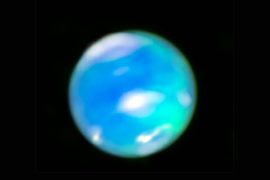Ruki River in the Democratic Republic of the Congo

Today’s Image of the Day from NASA Earth Observatory features the Ruki River in the Democratic Republic of the Congo (DRC). It is a tributary of the Congo River, one of the largest rivers in the world by discharge and depth.
The Ruki River, previously known as the Busira, merges with the Momboyo River near the town of Basankusu to become the Lulonga River, which eventually flows into the Congo River at the town of Lisala.
Dark waters of the Ruki River
“If the appearance of the muddy Amazon River evokes a coffee cut with cream, the Ruki River, coursing gently through the Congo Basin, is like a dark tea,” said NASA.
“On its slow path through mostly untouched lowland rainforest in the Democratic Republic of Congo (DRC), the water leaches organic material from vegetation, prompting some researchers to think it is one of the darkest blackwater rivers on Earth.”
According to NASA, scientists are finding that the dissolved material in this distinctive water offers clues about the carbon cycle of tropical forests.
Organic compounds in the Ruki River
In a recent study, researchers measured the chemical composition and flow of the Ruki for the first time.
“The study reported that, as the water color suggests, the Ruki is rich in dissolved organic carbon compounds,” said NASA.
“It contains four times as much organic carbon as the Congo River and 1.5 times as much as the Rio Negro, the world’s largest blackwater river and a major tributary of the Amazon.”
Due to this heavy carbon load, the researchers concluded that tropical forests like those around the Ruki might not accumulate quite as much carbon as we once thought.
Significance of the river
The river is vital for the livelihoods of local communities. Fishing is a crucial activity, with many people depending on it for sustenance and income. The river also supports agriculture along its banks, where communities grow crops.
In many parts of the DRC, rivers like the Ruki are crucial transportation corridors due to the challenging and often nonexistent road infrastructure.
The river enables the movement of people and goods, facilitating trade and access to markets, health care, and education.
Wildlife of the Ruki River
The region around the Ruki River is home to diverse wildlife. It is part of the Congo Basin, the second-largest tropical rainforest area in the world, which is a critical habitat for endangered species.
Among the most notable species are elephants and chimpanzees, whose populations thrive in the surrounding forests. Other primates such as bonobos also live in this region, making it a critical area for primate conservation.
The river itself is home to various species of fish that are crucial to local livelihoods. Hippopotamuses and crocodiles are often found in the water.
Birds like kingfishers, herons, and egrets frequent the riverbanks – making it a haven for birdwatchers.
The Ruki River also supports several species of reptiles and amphibians – some of which are unique to the region.
Managing the river’s resources
The region faces several challenges, including deforestation, overfishing, and environmental degradation, which threaten its ecological balance and the livelihoods of people who depend on it.
Efforts to manage and conserve the river’s resources are vital for sustainable development.
Understanding and protecting the Ruki River and its surroundings are crucial for the DRC’s environmental sustainability, economic development, and the well-being of its communities.
Landscapes of the DRC
The Democratic Republic of Congo (DRC) boasts some of the most diverse and breathtaking landscapes in Africa, reflecting its vast size and ecological richness. Dominated by the Congo Basin, the country is a haven for biodiversity.
Beyond its rainforests, the DRC’s landscapes shift dramatically. In the east, the terrain rises into rugged mountains, including the Virunga and Rwenzori ranges, where snow-capped peaks like Mount Stanley pierce the sky.
This region is also marked by active volcanoes such as Mount Nyiragongo, which harbors one of the world’s largest lava lakes, creating a dramatic and otherworldly spectacle.
To the south and west, the country transitions to expansive savannas with rolling grasslands and scattered trees. These areas contrast sharply with the lushness of the forests, providing vital habitats for species like lions and antelope.
Rivers like the Ruki are a dominant feature, with the mighty Congo River coursing through the heart of the country. Its tributaries shape the lives of millions.
The image was captured by the OLI (Operational Land Imager) on Landsat 8.
Image Credit: NASA Earth Observatory
—–
Like what you read? Subscribe to our newsletter for engaging articles, exclusive content, and the latest updates.
Check us out on EarthSnap, a free app brought to you by Eric Ralls and Earth.com.
—–
News coming your way





















